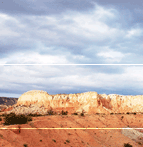What to Wear in New Mexico's Desert Country
New Mexico's high desert environment presents unique challenges that require thoughtful preparation and layered clothing strategies. With dramatic temperature swings, intense UV radiation, and unpredictable weather patterns, proper attire can make the difference between a comfortable adventure and a potentially dangerous situation. Understanding how to dress for this remarkable landscape ensures you can fully enjoy the stunning beauty of Plaza Blanca and the surrounding Abiquiu region.
Understanding New Mexico's Desert Climate
Extreme Temperature Variations: The high desert climate around Abiquiu can see temperature swings of 40-50°F within a single day. Summer days may reach 85-95°F while nights drop to 45-55°F. Winter days might be a pleasant 50-60°F, but nighttime temperatures often plunge below freezing. This dramatic variation requires a flexible layering system that can adapt throughout the day.
High Altitude Considerations: At over 6,000 feet elevation, the thin air provides little protection from UV radiation, making sun protection crucial year-round. The low humidity means sweat evaporates quickly, potentially leading to dehydration without obvious warning signs. Wind is common and can create significant chill factor, especially during cooler months.
Essential Layering System
Base Layer Foundation
Moisture-Wicking Materials: Choose synthetic fabrics or merino wool that wick sweat away from your skin. Avoid cotton base layers, which retain moisture and lose insulating properties when wet. Long-sleeve base layers provide sun protection while allowing airflow, often feeling cooler than short sleeves in direct sunlight.
UPF-Rated Clothing: Look for shirts and pants with UPF (Ultraviolet Protection Factor) ratings of 30 or higher. Many outdoor clothing manufacturers now offer lightweight, breathable fabrics specifically designed for desert conditions that provide excellent sun protection while maintaining comfort.
Mid-Layer Flexibility
Insulating Options: Pack a lightweight fleece or synthetic insulation jacket for temperature regulation during cooler morning starts, evening activities, or unexpected weather changes. These layers should be easy to pack away when temperatures rise during midday hiking.
Convertible Clothing: Zip-off pants that convert to shorts provide ultimate flexibility for changing conditions. Similarly, shirts with roll-up sleeves and ventilation zips allow for quick adjustments as temperatures fluctuate throughout the day.
Outer Layer Protection
Wind and Rain Shell: A lightweight, packable wind shell protects against the constant high desert breezes and occasional rain showers. Look for jackets with ventilation features to prevent overheating when weather conditions change rapidly.
Seasonal Clothing Strategies
Spring (March-May) Recommendations
Variable Weather Preparedness: Spring offers some of the best weather but also the most unpredictable conditions. Morning temperatures in the 40s can rise to 70s by afternoon. Pack layers including a warm hat and gloves for early starts, but be prepared to strip down to lightweight hiking clothes by midday. Wind is particularly common during spring months.
Essential Spring Items: Lightweight hiking pants, convertible shirt, fleece or light down jacket, wind shell, warm hat, sun hat, and lightweight gloves. Spring can bring unexpected snow at higher elevations, so monitoring weather forecasts is crucial.
Summer (June-August) Considerations
Heat Management: Summer hiking requires early morning starts to avoid dangerous afternoon temperatures. Long-sleeve, lightweight shirts provide better protection than short sleeves, while loose-fitting pants prevent overheating better than shorts in direct sun. Light colors reflect heat more effectively than dark clothing.
Critical Summer Gear: Wide-brimmed hat with chin strap, long-sleeve UPF shirt, lightweight hiking pants, breathable hiking socks, and gaiters to keep sand and debris out of shoes. Consider cooling towels and electrolyte replacement strategies for longer hikes.
Fall (September-November) Balance
Perfect Hiking Conditions: Fall offers ideal temperatures with warm days and cool nights. This season provides the most comfortable hiking conditions, but early season can still see hot days while late fall may bring winter-like conditions. The key is maintaining flexibility while enjoying the most stable weather patterns of the year.
Fall Essentials: Mid-weight hiking pants, long-sleeve base layer, light insulation layer, rain protection, and both warm and sun hats. Late fall visits should include warmer clothing options as winter conditions can arrive suddenly.
Winter (December-February) Challenges
Cold Weather Preparedness: Winter hiking in the high desert requires serious cold weather gear. While sunny days can be pleasant, temperatures often remain below freezing, and snow is common. Wind chill can create dangerous conditions even on relatively mild days.
Winter Necessities: Insulated hiking boots, warm base layers, insulation jacket, waterproof/breathable outer shell, warm hat and gloves, neck gaiter or balaclava, and microspikes or crampons for icy conditions. Wool or synthetic socks become critical for maintaining warm, dry feet.
Footwear Considerations
Sturdy Hiking Boots: The rocky, uneven terrain around Plaza Blanca demands ankle support and protection from sharp rocks. Mid-height hiking boots with good tread provide stability and protection while allowing adequate airflow. Avoid lightweight running shoes unless you're experienced with this terrain type.
Sock Strategy: Merino wool or synthetic hiking socks prevent blisters and maintain comfort in varying temperatures. Consider carrying an extra pair for longer hikes, as feet can get sandy or wet from stream crossings.
Gaiters: These underrated accessories keep sand, gravel, and plant debris out of your boots, significantly improving hiking comfort. They're particularly valuable when exploring the sandy washes and rocky scrambles common around Plaza Blanca.
Sun Protection Essentials
Head and Neck Coverage: A wide-brimmed hat with UPF rating provides crucial protection for face, ears, and neck. Many hikers prefer hats with chin straps to prevent loss in windy conditions. Neck gaiters or bandanas offer additional protection for exposed neck areas.
Eye Protection: High-quality sunglasses with 100% UV protection are non-negotiable in the high desert. Consider glacier glasses for extended snow travel or extremely bright conditions. Wraparound styles protect against wind and reflected light from sand and rock surfaces.
Skin Protection: Apply broad-spectrum SPF 30+ sunscreen to all exposed skin, including lips, ears, and the back of hands. Reapply every two hours or after sweating. Zinc-based sunscreens work well for sensitive skin and provide longer-lasting protection.
Specialized Gear Recommendations
Photography Considerations: Photographers should consider gloves that allow finger dexterity for camera operation, lens cloths for dust protection, and extra padding in pockets for delicate equipment. The fine sand around Plaza Blanca can damage electronic equipment if proper precautions aren't taken.
Emergency Preparedness: Always carry an emergency shelter (space blanket or bivy), extra food and water, first aid supplies, and signaling devices. The remote nature of many hiking areas means self-rescue capabilities are essential. Weather conditions can change rapidly, creating dangerous situations for unprepared visitors.
Packing Strategy
Day Pack Essentials: A 20-30 liter daypack provides adequate space for clothing layers, emergency gear, food, and water without excessive weight. Include compression straps for securing removed layers and external attachment points for muddy or wet items.
Multi-Day Considerations: For extended visits involving multiple activity types, pack clothes that serve double duty. Quick-dry hiking pants work for both trail activities and casual restaurant dining. Merino wool base layers provide odor resistance for extended wear.
By understanding the unique challenges of New Mexico's high desert environment and preparing with appropriate clothing systems, visitors can safely and comfortably explore the remarkable landscapes around Plaza Blanca throughout the year. Remember that conditions can change rapidly, and it's always better to be slightly over-prepared than caught without essential protection in this unforgiving but magnificent environment.
Plaza Blanca Guide -
How To Get Here -
Unofficial guide. Not associated in any way with the Dar Al Islam
Center or Georgia O'Keeffe's estate
|









